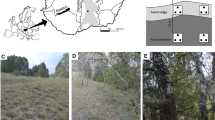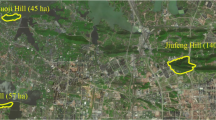Abstract
Planted woodland islets act as sources of seed that may accelerate woodland development in extensive agricultural landscapes. We assessed a 1-ha plot that was planted with 16 100-m2 islets of holm oak Quercus ilex subsp. ballota seedlings near Toledo (Spain) in 1993. In spring 2014 we measured (1) acorn predation and (2) seedling emergence from seeded acorns at different distances from and orientations around the islets with half of the acorns protected to prevent predation, (3) survival of emerged seedlings, and (4) natural tree establishment outside of the planted islets. Most (96.9 %) unprotected acorns were removed or predated. Seedling emergence from protected acorns ranged from 42.9 % on the northern side of the islets to 13.2 % on the southern side, suggesting a less stressful microclimate on the northern side. Survival of naturally established seedlings was 28.6 % by the end of first summer; seedling mortality was chiefly due to drought (45.0 %) and herbivory (35.0 %). Density of emerged seedlings, surviving seedlings after first dry season, and established oaks >1-year old was similar at different distances from the islets. Over the 21 year time period, 58 new oak individuals >1-year old have established (an average of 3.3 established individuals per ha per year) at an average distance of 6.3 ± 5.4 m away from the closest islet. We conclude that initial oak regeneration triggered by small planted islets in Mediterranean abandoned farmland is slowed down by high acorn predation, seedling herbivory, and stressful microclimatic conditions. Regardless, these islets are a viable tool for regeneration of Mediterranean oak woodland.




Similar content being viewed by others
References
Adams TE, Sands PB, Weitkamp WH, McDougald NK (1992) Oak seedling establishment on California rangelands. J Range Manag 45:93–98
Akaike H (1987) Factor analysis and AIC. Psychometrika 52:317–332
Allison PD (1995) Survival analysis using the SAS® system. A practical guide. SAS Institute, Cary
Bartholomew B (1970) Bare zone between California shrub and grassland communities: the role of animals. Science 170:1210–1212
Barton (2014) MuMIn: multi-model inference. R package version 1.10.5. http://CRAN.R-project.org/package=MuMIn
Bates D, Maechler M, Bolker B, Walker S (2014) lme4: linear mixed-effects models using eigen and S4. R package version 1.1-7
Bonet A, Pausas JG (2004) Species richness and cover along a 60-year chronosequence in old-fields of southeastern Spain. Plant Ecol 174:257–270
Burnham KP, Anderson DR (2002) Model selection and multimodel inference: a practical information-theoretic approach, 2nd edn. Springer, New York
Castro J, Zamora R, Hódar JA (2006) Restoring Quercus pyrenaica forest using pioneer shrubs as nurse plants. Appl Veg Sci 9:137–142
Castro J, Leverkus AB, Fuster F (2015) A new device to foster oak forest restoration via seed sowing. New Forests (accepted with pending revision)
Corbin JD, Holl KD (2012) Applied nucleation as a forest restoration strategy. For Ecol Manag 265:37–46
Cuesta B, Villar-Salvador P, Puértolas J, Peñuelas JL, Rey JM (2010a) Facilitation of oak in Mediterranean shrubland is explained by both direct and indirect interactions mediated by herbs. J Ecol 98:688–697
Cuesta B, Villar-Salvador P, Puértolas J, Jacobs D, Rey-Benayas JM (2010b) Why do large, nitrogen rich seedlings better resist stressful transplanting conditions? A physiological analysis in two functionally contrasting Mediterranean forest species. For Ecol Manag 260:71–78
Del Campo AD, Navarro RM, Ceacero CJ (2010) Seedling quality and field performance of commercial stocklots of containerized holm oak (Quercus ilex) in Mediterranean Spain: an approach for establishing a quality standard. New For 39:19–37
Díaz M, González E, Muñoz-Pulido R, Naveso MA (1996) Habitat selection patterns of common cranes Grus grus wintering in holm oak Quercus ilex Dehesas of central Spain: effects of human management. Biol Conserv 75:119–123
Fox GA (1993) Failure-time analysis: emergence, flowering, survivorship, and other waiting times. In: Gurevitch J, Scheiner SM (eds) Design and analysis of ecological experiments. Chapman and Hall, New York, pp 253–289
García X, Ferrer P (2013) La creación de núcleos de dispersión y reclamo como modelo de restauración ecológica forestal. In: Martínez C, Lario FJ, Fernández B (eds) Avances en la restauración de sistemas forestales. Técnicas de implantación. SECF-AEET, Madrid, España, pp 149–158
García-Barreda S, Reyna S (2013) Short-term dynamics of Quercus ilex advance regeneration in a Pinus nigra plantation after the creation of small canopy gaps. For Syst 22:179–188
Gómez JM (2003) Spatial patterns in long-distance dispersal of Quercus ilex acorns by jays in a heterogeneous landscape. Ecography 26:573–584
Gómez JM, Hódar JA (2008) Wild boars (Sus scrofa) affect the recruitment rate and spatial distribution of holm oak (Quercus ilex). For Ecol Manag 256:1384–1389
Gómez JM, García D, Zamora R (2003) Impact of vertebrate acorn- and seedling-predators on a Mediterranean Quercus pyrenaica forest. For Ecol Manag 180:125–134
Gómez JM, Puerta-Piñero C, Schupp EW (2008) Effectiveness of rodents as local seed dispersers of holm oaks. Oecologia 155:529–537
Gómez-Aparicio L, Zavala MA, Bonet FJ, Zamora R (2009) Are pine plantations valid tools for restoring Mediterranean forests? An assessment along abiotic and biotic gradients. Ecol Appl 19:2124–2141
Guzmán JM, Nadal S, Román B (2008) Ensayo preliminar de reforestación con especies facilitadoras: nascencia de encina bajo retama en condiciones semiáridas. Cuadernos de la Sociedad Española de Ciencias Forestales 28:61–65
Joët T, Ourcival JM, Dussert S (2013) Ecological significance of seed desiccation sensitivity in Quercus ilex. Ann Bot 111:693–701
Leiva MJ, Fernández R (2003) Post-dispersive losses of acorns from Mediterranean savannah-like forests and shrublands. For Ecol Manag 176:265–271
Leverkus AB, Castro J, Puerta-Piñero C, Rey Benayas JM (2013) Suitability of the management of habitat complexity, acorn burial depth, and a chemical repellent for post-fire reforestation of oaks. Ecol Eng 53:15–22
Leverkus AB, Castro J, Rey Benayas JM (2014) Regeneración post-incendio de la encina en pinares de repoblación mediterráneos. Ecosistemas 23:48–54
Maestre FT, Cortina J, Bautista S, Bellot J, Vallejo VH (2003) Small-scale environmental heterogeneity and spatiotemporal dynamics of seedling establishment in a semi-arid degraded ecosystem. Ecosystems 6:630–643
Montero MJ, Moreno G, Bertomeu M (2008) Light distribution in scattered-trees open woodlands in Western Spain. Agrofor Syst 73:233–244
Moreno JM, Zuazua E, Pérez B, Luna B, Velasco A, Resco De Dios V (2011) Rainfall patterns after fire differentially affect the recruitment of three Mediterranean shrubs. Biogeosciences 8:3721–3732
Navarro LM, Pereira HM (2012) Rewilding abandoned landscapes in Europe. Ecosystems 15:900–912
Oliet JA, Artero F, Cuadros S, Puértolas J, Luna L, Grau JM (2012) Deep planting with shelters improves performance of different stocktype sizes under arid Mediterranean conditions. New For 43:925–939
Perea R, San Miguel A, Gil L (2011) Leftovers in seed dispersal: ecological implications of partial seed consumption for oak regeneration. J Ecol 99:194–201
Pérez-Ramos IM, Marañón T (2008) Factors affecting post-dispersal seed predation in two coexisting oak species: microhabitat, burial and exclusion of large herbivores. For Ecol Manag 255:3506–3514
Pons J, Pausas JG (2007a) Acorn dispersal estimated by radio-tracking. Oecologia 153:903–911
Pons J, Pausas JG (2007b) Rodent acorn selection in a Mediterranean oak landscape. Ecol Res 22:535–541
Puerta C, Pino J, Gómez JM (2012) Direct and indirect landscape effects on Quercus ilex regeneration in heterogeneous environments. Oecologia 170:1009–1020
Puértolas J, Oliet JA, Jacobs DF, Benito LF, Peñuelas JL (2010) Is light the key factor for success of tube shelters in forest restoration plantings under Mediterranean climates? For Ecol Manag 260:610–617
Pulido FJ, Díaz M (2005) Regeneration of a Mediterranean oak: a whole-cycle approach. Ecoscience 12:92–102
Purves D, Zavala M, Oglel K, Prieto F, Rey Benayas JM (2007) Coupling environmental forcing, metapopulation dynamics, and dispersal of Quercus species in central Spain. Ecol Monogr 77:77–97
Ramos-Palacios CR, Badano EI, Flores J, Flores-Cano JA, Flores-Flores JL (2014) Distribution patterns of acorns after primary dispersion in a fragmented oak forest and their consequences on predators and dispersers. Eur J For Res 133:391–404
Rey Benayas JM (1998) Growth and survival in Quercus ilex L. seedlings after irrigation and artificial shading on Mediterranean set-aside agricultural land. Ann Sci For 55:801–807
Rey Benayas JM, Bullock JM (2012) Restoration of biodiversity and ecosystem services on agricultural land. Ecosystems 15:883–889
Rey Benayas JM, Bullock JM (2015) Vegetation restoration and other actions to enhance wildlife in European agricultural landscapes. In: Pereira HM, Navarro LM (eds) Rewilding European Landscapes, Springer International Publishing Switzerland, pp 127–142. doi: 10.1007/978-3-319-12039-3_7
Rey Benayas JM, Camacho A (2004) Performance of Quercus ilex saplings planted in abandoned Mediterranean cropland after long-term interruption of their management. For Ecol Manag 194:223–233
Rey Benayas JM, Navarro J, Espigares T, Nicolau JM, Zavala MA (2005) Effects of artificial shading and weed mowing in restoration of Mediterranean abandoned cropland with contrasting Quercus species. For Ecol Manag 212:302–314
Rey Benayas JM, Bullock JM, Newton A (2008a) Creating woodland islets to reconcile ecological restoration, conservation, and agricultural land use. Front Ecol Environ 6:329–336
Rey Benayas JM, Cuesta B, Villar-Salvador P, Jaúregui P (2008b) Life-history traits in an evergreen Mediterranean oak respond differentially to previous experimental environments. Web Ecol 8:74–83
R Core Team (2014) R: a language and environment for statistical computing. R Foundation for Statistical Computing, Vienna, Austria. URL
Smit Ch, Díaz M, Jansen P (2009) Establishment limitation of holm oak (Quercus ilex subsp. ballota (Desf.) Samp.) in a Mediterranean savanna–forest ecosystem. Ann For Sci 66:511–517
Stanturf JA, Palik BJ, Williams MI, Dumroese RK, Madsen P (2014) Forest restoration paradigms. J Sustain For 33:S161–S194
Valdecantos A, Cortina J, Vallejo VR (2006) Nutrient status and field performance of tree seedlings planted in Mediterranean degraded areas. Ann For Sci 63:249–256
Vallejo R, Aronson J, Pausas JG, Cortina J (2006) Restoration of Mediterranean woodlands. In: van Andel J, Aronson J (eds) Restoration ecology: the new frontier. Blackwell, Oxford, pp 193–207
Villar-Salvador P, Nicolás JL, Heredia N, Uscola M (2013) Quercus ilex L. In: Pemán J, Navarro-Cerrillo RM, Nicolás JL, Prada MA, Serrada R. (Coords.) Producción y Manejo de Semillas y Plantas Forestales. Tomo II. Organismo Autónomo Parques Nacionales. Serie Forestal. Ministerio de Agricultura, Alimentación y Medio Ambiente, Madrid, España. pp 226–250
Waite RK (1985) Food caching and recovery by farmland corvids. Bird Study 32:45–49
Zahawi RA, Holl KD, Cole RJ, Reid L (2013) Testing applied nucleation as a strategy to facilitate tropical forest recovery. J Appl Ecol 50:88–96
Zamora E, Peinado M, Sánchez M, Galleo J, Mata C (1985) Consumo de bellota por conejos en pastoreo continuo. Archivos de Zootecnia 34:257–264
Zamora R, Hódar JA, Matías L, Mendoza I (2010) Positive adjacency effects mediated by seed disperser birds in pine plantations. Ecol Appl 20:1053–1060
Zavala MA, Espelta JM, Retana J (2000) Constraints and trade-offs in Mediterranean plant communities: the case of holm oak-Aleppo pine forests. Bot Rev 66:119–149
Acknowledgments
Projects from the Spanish Ministry of Science and Education (CGL2010-18312 and CGL2014-53308-P) and the Government of Madrid (S2013/MAE-2719, REMEDINAL-3) are currently providing financial support for this body of research. We are indebted to Aurora Mesa and Paula Meli for their help for acorn seeding and to Laura Fernández and Luis Cayuela for their input with some statistical analyses. The subject editor and two anonymous reviewers provided valuable comments on a former version of this manuscript.
Author information
Authors and Affiliations
Corresponding author
Electronic supplementary material
Below is the link to the electronic supplementary material.
Rights and permissions
About this article
Cite this article
Rey Benayas, J.M., Martínez-Baroja, L., Pérez-Camacho, L. et al. Predation and aridity slow down the spread of 21-year-old planted woodland islets in restored Mediterranean farmland. New Forests 46, 841–853 (2015). https://doi.org/10.1007/s11056-015-9490-8
Received:
Accepted:
Published:
Issue Date:
DOI: https://doi.org/10.1007/s11056-015-9490-8




